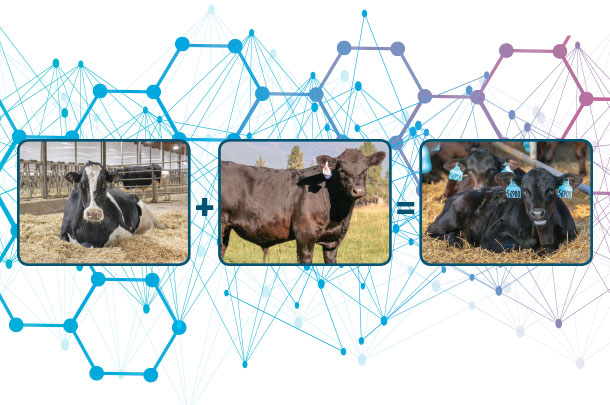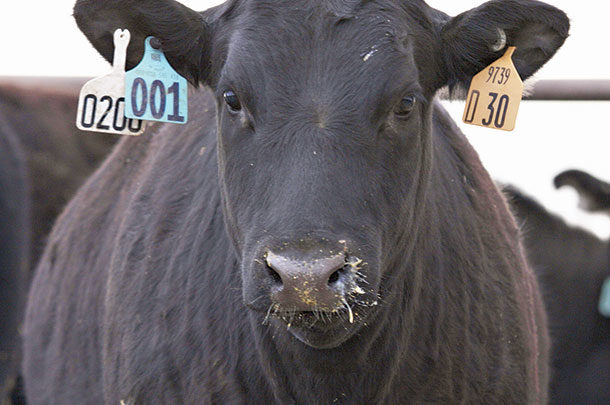“It’s really taken off, and the thing that started it was the fact that we see a big discount on straight Holstein cattle in the marketplace,” says Wade Small, president of the Agri-Beef Livestock Division. “Dairies are looking for ways to maintain their business model, and the dairy cross is a way to do it.”
And while the beef-on-dairy trend isn’t new, industry experts are starting to pay more attention to the effects it will have on both the beef and dairy industry, sparking new questions and a need for formal research.
Dale Woerner, animal science professor at Texas Tech University, is helping lead an academic research study to provide data around the value a beef-on-dairy cow brings to the marketplace. In January, he and 30 industry representatives met to kick off what will be the first organized research study on the beef-dairy cross.

“We’re focusing on improving efficiencies for the beef industry with this study. Statistics say that around 20 percent of the beef market is a dairy start, and this is the best way to influence one out of five animals being harvested. That specific 20 percent is the lowest hanging fruit to improve the efficiency of beef production,” Woerner says. “I don’t think it will offset the market. These animals will be higher value than the straight Holstein. I’m not worried about changing supply, but research tells us we will improve efficiency and the amount of beef produced per animal.”
The study is set to last around three to four years, but Woerner sees it becoming a longer-term, multidisciplinary study covering red meat yield, retail cutting yield, nutrition, lactation, feed production, environmental impact, water usage and consumer acceptance.
“The energy in the room was positive and the conversations were great. Our industry is moving forward with the beef-on-dairy scenario,” Woerner says. “The timing is good in the sense that the dairy industry needs help becoming profitable today, and it’s a great time for them to add value to the calf which has always been a ‘byproduct’ to the dairy producer, but it’s really a ‘co-product,’ and the more value we can add to that, the more profitable they can become.”
But will that profit come at a price for the beef industry? Experts say it shouldn’t be a game changer for beef producers, but the packing industry could find itself at capacity.
“I don’t see this having a big seismic shift for the overall marketplace. If there is a limiter on our production, it tends to be on our packing capacity, but I don’t think this will present a huge concern,” Mark McCully, vice president of production for Certified Angus Beef, says.
Dairy producers are also concerned about flooding the market as more and more of them find ways to mitigate financial risk with the current milk prices.
Jonathan Lamb of Oakfield Corners Dairy says while they are new to the beef-on-dairy trend, it was a calculated business decision.
“With the advent of genomics, there has been a lot of pharmaceutical companies that can help us cull our bottom end, but the cost of that is the genomic test and raising that calf. But if we breed to beef, we can cull immediately upon birth so dairymen see that as a much more practical application,” he says. “This is widely being done. When we raise extra heifers, it becomes extremely expensive, and we don’t need them, so it doesn’t make sense to raise them.”
Lamb says A.I. companies have been trying to brand their products by using genetics that will breed well with Holstein cows, and experts in both the dairy and beef industries say the advanced genetics and reproduction tools available provide good timing for the beef-dairy cross to become mainstream. But Small warns it must be done carefully.
“As this grows, the quality of the beef side is really important. There is a difference between programs selecting the right bulls and those that have a program and a vested interest in the end product,” he says. “I’ve seen a load that will have every breed under the sun represented, and that is the wrong message to send. Not all beef-dairy crosses are created equal. These bigger dairies who are retaining ownership on those calves all the way through to market – those are the guys who will benefit the most and add the most value to the cattle.”
Tom Lawlor, a geneticist and director of research at Holstein Association USA, says people who have a better handle on their breeding programs, like Oakfield Corners Dairy, are more apt to be practicing beef-on-dairy.
“Counter to being worried about genetics, we have the ability to bring in better genetics than ever before. With genomic testing, we can learn which animals are really superior, and breeding them to a beef bull makes perfect sense,” Lawlor says. “The genetics we are having come in are better than they have ever been, and it’s just adding some extra revenue to the farm at a very needed time.”
Lawlor says consumer perception will require a bit of education, but he estimates around 30 to 40 percent of USDA Prime is already coming from a dairy start.
“They grade very well, and dairy animals produce a lot of Prime cuts,” Lawlor says. “A lot of cattlemen wouldn’t think it, but while the yield may not be that good, the marbling and the eating satisfaction is very good.”
McCully says while the topic is a little sensitive, a half-dairy animal could qualify for a branded program.
“We do have a muscle confirmation specification, and if that animal has dairy-type muscling, which many of these do, they wouldn’t qualify for our program,” he says. “But if the cross has beef-type muscling and meets all of our other specifications, then those cattle could qualify for a branded program like Certified Angus Beef.”
As with any new trend, there are many learnings ahead of the two industries. Woerner says understanding the value a beef-dairy cross brings to the marketplace will take time.
“We can make the genetic side very similar so the common denominators are there. The uncommon denominator is the feeding sector. A big discussion point is how do we feed these animals? A considerable amount of research needs to be done to perfect the way we feed these animals and not just for high levels of marbling,” Woerner says. “It’s a wide and deep concept. It’s complex, and there are lots of players involved.” ![]()
PHOTO: As more dairies use beef semen to increase marketing opportunities, the impact it will have on the beef industry remains uncertain. Photo courtesy of ABS Global.
ILLUSTRATION: Illustration by Carrie Stockebrand.
Amy Schutte is a freelance writer based in Idaho.






